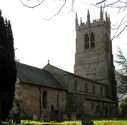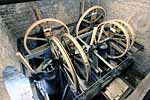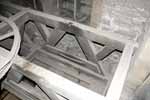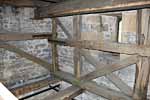 Rolleston Rolleston
Holy Trinity
Bells
During the restoration of the church in the 1890’s attention was directed to the re-hanging of the bells. Three of them were resting in an old pew in the south aisle, and the one in use was very unsafe. The whole of the floors, ladders, frames and other woodwork in the tower were in an advanced state of decay. The restoration was carried out in 1892. The tower itself was restored in 1889-90, its previous condition having become critical. It was at this time that the former west gallery was removed.
A board in the ringing chamber is inscribed:

Rolleston Church
The four bells were re-hung
by Robert Lee of Averham,
and used for the first time
after many years silence
on Easter Day 1892.
| G. D. WHARAM, M.A. |
|
VICAR |
| T. S. CULLEN |
{ |
CHURCH
WARDENS |
| JAMES GREGORY |
{ |
| WILLIAM WRIGHT |
{ |
|
| |
Inscription |
Size |
Weight |
Dated |
Founder |
| 1 |
THY KINGDOM COME, O GOD
O PRAISE YE THE LORD
Parish Priest: Susan Spencer, Churchwardens: Kate Haydock and Ray Lowe |
27.38" |
5-1-0 |
2000 |
John Taylor, Bellfounders of Loughborough |
| 2 |
|
30.00" |
5-1-26 |
2001 |
John Taylor, Bellfounders of Loughborough |
| 3 |
GOD SAVE HIS CHURCH. N.W. (?) W. WARDENS 1697 |
33.13" |
7-0-9 |
1697 |
William Noone of Nottingham |
| 4 |
I sweetly toling men do call to taste on meats that feede the soule 1628 |
35.50" |
8-1-1 |
1628 |
George Oldfield I of Nottingham |
| 5 |
ILLI FECERENT ME IN HONORE TRENITATIS
(They made me in honour of the Trinity) |
38.50" |
9-3-23 |
c1370 |
Johannes de Yorke (?) of Leicester |
6 |
ALL YOU THAT HEAR MY MOURNFULL SOUND REPENT BEFORE YOUR LAYD IN GROUND. ROBT. WISE & ROBT. LONG CHURCH WARDENS THOS. HEDDERLY FOUNDER NOTTINGHAM 1778. |
43.50" |
13-3-24 |
1778 |
Thomas Hedderley II of Nottingham |
One very interesting feature about the tenor (sixth) bell is the fact that four coins are inserted in the iron near the crown of the bell. The first coin is a George III shilling; the second is a George II half-crown, and these two show the obverse or head side of the coins. The third coin a George II crown, dated 1746; the fourth coin is a George II guinea, and these two show the reverse side.
The peal was re-tuned to the key of F# to harmonise with the ancient fifth bell.
The bells had not been rung in peal for over 30 years, but in the year 2000 the challenge to get the bells ringing was taken up by a parishioner, Nick Pearson who, with Gill Rowles, spearheaded the project which cost some £25,000. Their amazing fund-raising capabilities enables the existing bells to be retuned, a second-hand bell cast in the year 2000 to be purchased, and a further bell to be cast specifically for the church; the latter was cast on 1 November 2001, with a party of some 25 parishioners witnessing the casting. The bells were rededicated on 9 December 2001.
During test ringing of the bells in the old frame, considerable motion was set up in the bellframe foundation structure proving it to be totally inadequate for its purpose. A new galvanised steel bell frame was therefore installed lower in the tower, and the interesting old wooden frame preserved. The project was managed by Haywood Mills Associates of Nottingham. A new ringing room was created.
 Steel bell frame Steel bell frame |
 Old wooden bellframe Old wooden bellframe
(upper tower level) |
 Old wooden bellframe Old wooden bellframe
(mid-tower level) |
The Churchwarden’s accounts for the 18th century indicate an active tower:
1st January 1750/1 |
paid for five ringing days |
0.12.6
|
22 September 1761 |
Ringers |
7/6d King Crow’d (sic) |
The recasting of the tenor in 1778 is well recorded:
8th February 1778 |
Pd for 2 letters from the Bellfounder |
0.0.2
|
|
Journeys to Nottingham, horse and charges about the bell |
0.9.0
|
|
Spent on the man that assisted when fetching the bell from cart Bridge |
0.4.0
|
19th April |
The Bellfounders Bill |
23.5.6 |
Thomas Hedderley’s notebook records the bell thus:
Rolleston Tenor 44 inch wide
3 inch bate 1/8 thick 32 high betwixt A & G 156..1..11
There were some questions raised about the tower in an assessment made by the Diocesan Bell advisor in his report dated 30th September 2000:
- Why were three of the four matching windows in the ringing chamber been removed and infilled with stone? When was it done? Was it done to strengthen the tower and if so, why? Could these possibly have been the original belfry windows before the tower was raised to its present height? Were the bells ever accommodated in what was (in 2000) the intermediate chamber and of so why were they moved up to the 2000 belfry. When were the steel tie bars inserted at various levels in the tower?
- Did the timber bellframe-like structures adjacent to the north and south wall of the intermediate chamber form part of the medieval bellframe? If so, why was it two tiered? If not, what was the purpose of the structure? Why was it left in situ when the bells were moved up to the present belfry as it appears to serve no other useful purpose? When were the bells moved up, if indeed they were moved up, and most certainly it must have been before the 1892 tower restoration?
- What happened to the church clock which at one time struck on the tenor bell? It certainly existed after the bells were quarter turned judging by the wear on the outside of the tenor bell and certainly before the bells were hung in the present (1892) bellframe?
- When were the bells quarter turned? Judging by the present clapper wear on the bells it was well before 1892. Why is the preceding clapper wear on the third bell much more pronounced than on the other three bells? Is it purely down to the age of the bell?
- It is quite probable the bells were raised up to the present belfry level when the tower was raised in height and tree ring dating of the three original belfry support timber beams would probably confirm this. It is also probable that Robert Lee of Averham who made and installed the present bell frame in 1892 copied much of what was already there and reused many of the existing fittings, particularly the clappers, which were of an outdated pattern even by that date.
- Why and when did it become necessary to frill and fit a false crown staple in the second bell? Was it in 1892 or possibly earlier or even later?
All the older bells are of considerable historical interest. The oldest bell in the tower is the third bell which was cast at the Leicester bell foundry by Johannes de Yorke c1370. All the others were cast at the Nottingham bell foundry. The second bell by George Oldfield I the master founder in 1628, the treble by William Noone in 1697. William Noone was the assistant to George Oldfield I until George’s death in 1678 at which time he began casting in his own right. Finally the tenor is an early bell cast by Thomas Hedderley II in 1778 and contains amongst its inscription the impression of a George III shilling and a George II half crown.
|